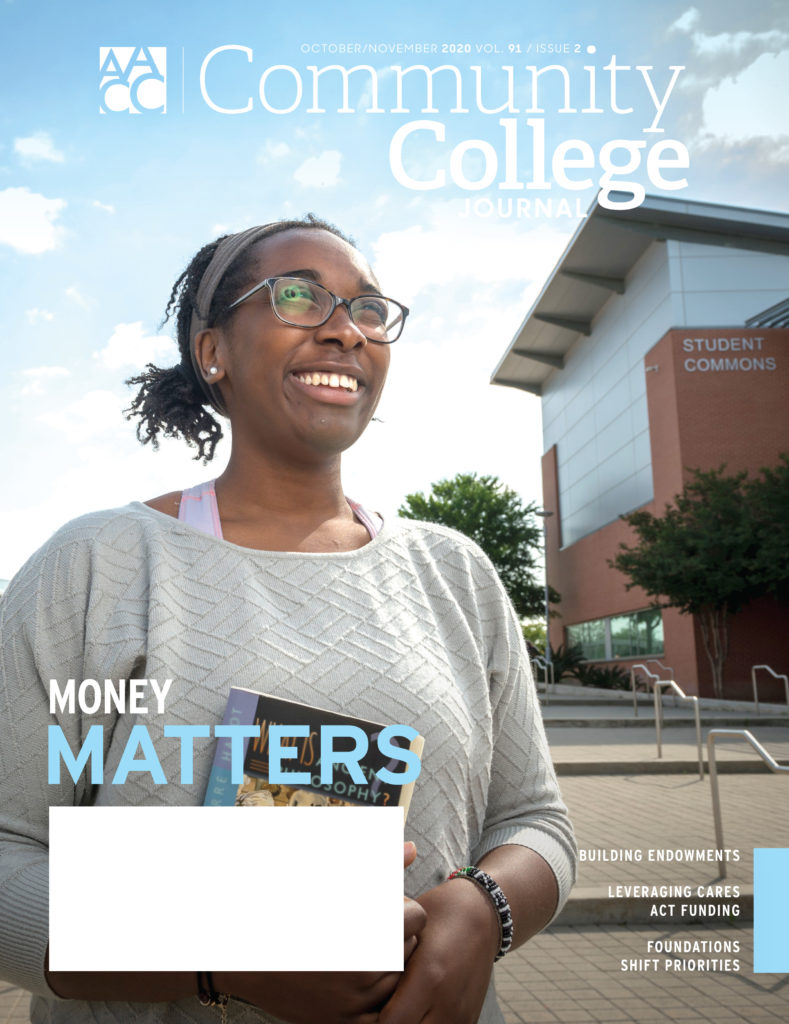The global pandemic has disrupted life as we know it. And it has had far-reaching effects on both education and the economy.
Millions of people have lost their jobs. College budgets have taken a wallop. Some students have had to pause their studies, which others have struggled academically in the transition to remote learning.
But there’s a sliver of good news amid all the gloom: Many foundations and individual donors are stepping up to help students and their institutions during this period of crisis. As the coronavirus forced businesses and colleges to shut down this past spring, several funders responded with grants to help nonprofit organizations dole out aid to those who were affected.
This excerpt comes from the current issue of the Community College Journal, which is published bi-monthly by the American Association of Community Colleges.
For instance, the ECMC Foundation gave $1.75 million to four organizations providing emergency relief to students, including $500,000 for Believe in Students to distribute aid through an online platform called Edquity. ECMC also gave 65 “rapid response” grants of $10,000 each to existing grantees — including some community colleges — to cover pandemic-related costs.
“When their assets take a hit, many foundations tend to pull back and make fewer grants,” says ECMC Foundation President Peter Taylor. “We’ve taken the opposite approach. We’ve decided to double down by committing an extra $5 million this year and next year to help us better respond to the needs of higher education.”
Stepping up
A survey of philanthropic individuals by Fidelity Charitable suggests that ECMC isn’t alone. The survey found that most donors planned to maintain (54%) or even increase (25%) their charitable giving this year. In March alone, grant volumes from Fidelity’s donor-advised investment account reportedly increased by 36% over the prior year.
Now that the initial shockwave created by the pandemic is over, foundations are shifting their focus. Instead of providing emergency aid, many are now funding longer-term projects that respond to newly emerging needs and priorities.
These include retraining displaced workers, addressing inequities exposed by the pandemic, and improving online teaching and learning.
Community colleges are central to these efforts. This makes them well positioned to benefit from funders’ generosity.
“Community colleges are doing the most to create opportunity in America,” says Chauncy Lennon, vice president of learning and work at Lumina Foundation. “They play a critical role in addressing the challenges we face today, and there is no better time than the present to convince funders just how important they are.”
Fueling the economic recovery
Covid and the measures taken to limit the virus’ transmission have led to the loss of 14 million jobs in the U.S., Lumina Foundation observes. The national unemployment rate increased from 3.8% in February to 11.1% in June.
Lumina and other funders are launching programs to help adults who’ve lost their jobs get the training they need to reenter the job market — and they note that community colleges are essential in realizing this goal.
“We expect a surge in community college enrollments, especially as dislocated workers and other adults seek retraining and upskilling. Workers in low-wage jobs, many still struggling to recover from the previous recession, are once again the most severely affected and will depend on training in community colleges for new and better jobs,” Lennon says.
Lumina and the Siemens Foundation have teamed up to fund a 20-state initiative called the Reskilling and Recovery Network. A partnership between the National Governors Association’s Center for Best Practices and the American Association of Community Colleges, the network will bring together state and community college leaders to devise strategies for scaling up short-term certifications and other workforce development programs. One goal is to figure out how to reopen campuses safely to get students who require hands-on training the instruction they need.
Lumina Foundation has also made a $1.85 million grant to New America Foundation to disseminate information about high-quality career preparation models at community colleges. And the Duke Energy Foundation has announced more than $1.1 million in grants for workforce development initiatives in Florida, Indiana and South Carolina since June. The grants included $100,000 for St. Petersburg College in Florida to recruit historically underserved students for programs that prepare them for energy careers.
Addressing social justice issues
Besides displacing millions of workers, the pandemic has revealed vast disparities along racial and social-economic lines.
The pandemic has disproportionally affected lower-income workers in service-sector jobs that don’t lend themselves to working from home. Among people who were working in February, nearly 40 percent of those in households making less than $40,000 a year had lost their job by the end of March, according to the Federal Reserve.
What’s more, the closing of schools and colleges has drawn attention to widespread food insecurity, lack of affordable child care and gaps in broadband access among low-income families. And the virus itself has ravaged communities of color in the U.S. at higher rates than white populations.
These disparities, coupled with the Black Lives Matter movement and the quest for racial justice in policing, have led to a surge in grant-giving for social justice issues.
“We must focus on voices who are disproportionally impacted by the Covid virus and the economic crisis it has created,” says Patrick Methvin, director of postsecondary success for the Bill & Melinda Gates Foundation. “We need to be listening to people of color.”
AT&T has committed $10 million to support upward mobility for Black and underserved communities facing social inequity and higher unemployment, which have been exacerbated by Covid. Duke Energy has pledged $1 million to nonprofit organizations committed to social justice and racial equity within the seven states where the company does business: North and South Carolina, Florida, Indiana, Ohio, Kentucky and Tennessee.
And the Gates Foundation is investing in a partnership with the Hope Center for College, Community, and Justice to help colleges retool their student support initiatives, so they can distribute emergency aid more effectively to students who need it. The Hope Center’s research suggests that at least one-third of undergraduate students were food or housing insecure before the pandemic, and those numbers have likely risen dramatically.
“How colleges build awareness of their emergency aid programs, and whether they process this funding rapidly for students, is important,” Methvin says. “If I’m a student who’s facing an emergency financial situation, and I make a request for emergency aid but it takes a week to process that request, I’ve probably already made my decision to drop out and reallocate my time. However, if I get that aid within 24 hours, it might change my decision. I might be able to stay with that education experience.”


